 |
HELLO, I am Friedemann and would like to tell you a bit about my new game Black Friday.
In this game, players try to earn the most gold and silver.
As the players start the game with no money, each must earn cash by skillful stock purchases and sales.
With this cash, they can acquire the precious metals needed to win the game.
And, naturally, the government will help distressed entrepreneurs by offering subsidies.
The player who can manipulate the market and stock values most skillfully in his favor
and sell his stock before the crash, has the best chance for victory! |
Contents
 1 game board 1 game board |
 125 briefcases 125 briefcases
(25 in 5 colors) |
 15 black briefcases 15 black briefcases |
 5 stock markers 5 stock markers
(1 in 5 colors) |

2 silver markers (gray) |

20 silver bars
20 gold bars |

5 level cards (2-sided) |
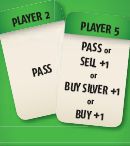
8 special action cards |
 money money |
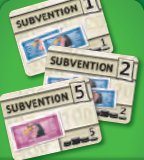 subsidy cards subsidy cards |
Preparation
Here we explain the game for 3 and 4 players.
When playing with 2 or 5 players, there are two tiny modifications, which are explained here.
Place the game board in the middle of the table.
Place the 5 stock markers on the game board on the value 7 space.
Place 1 silver marker on space 20 of the silver price table and 1 silver marker on space 0 of the silver buys table.
Place 2 briefcases of each color on each of the sales tables.
Place the number of black briefcases as shown on each of the sales tables (1, 2, and 3).
The sales tables will be used in order as the current sales table, starting with 1, then 2, and then 3.
After that, 2 and 3 will alternate.
Place the remaining 9 black briefcases on their supply on the game board.
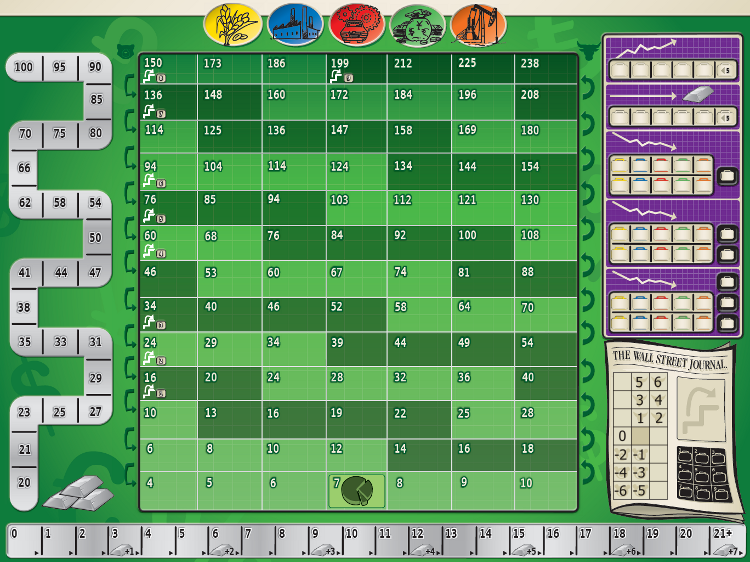
Place the 5 level cards in a stack on the space shown with the "start" card on top.
The 1-9 level cards will be used during the game as the marker moves from level to level.
Sort the money and subsidy cards separately and place them as supplies beside the game board.
Place 4 briefcases in each of the 5 colors next to the game board as the market.
Then count 10 plus the number of players in each of these colors and place these in the cloth bag.
Remove the remaining briefcases from the game.
Each player takes a player screen and draws 5 random briefcases from the bag, placing them behind his player screen.
The players choose a starting player.
He draws 20 more briefcases randomly from the bag and adds these to the market.
In clockwise order, each player, except the starting player, takes the appropriate special action card.
In the first game or two, we recommend you play without the special action cards.
Although this gives the starting player a small advantage, this will not become apparent in the first games.
Experienced players should use the special action cards to ensure a balanced and fun game.
Example
First, place 4 briefcases of each color in the market beside the game board.
With 4 players, place 14 briefcases of each color into the bag and the rest back in the box.
Next, each player, in clockwise order, draws 5 briefcases randomly from the bag and places these behind his player screen.
Finally, the start player draws 20 more briefcases randomly from the bag and places them in the market.
Level card
 |
The level card has three items:
At the top is the subsidy limit (here 8): this is the total number of subsidies a player may have.
The buy limits (here 5 and 5) indicate how many shares or how many silver bars a player may buy using the appropriate action.
And at the bottom is the specification of how many briefcases are drawn from the bag during a price adjustment (here 11). |
Playing the game
On his turn, a player takes exactly one of the following four actions:
- Buy shares
- Sell shares
- Buy silver
- Pass
In addition, the player may take a subsidy (always 20$) and/or use his special action.
Then the next player takes his turn.
If there are exactly five colored briefcases on a sales table after an action, a price adjustment is immediately initiated.
The black briefcases are not considered in this count!
1. Buy shares
Players buy shares at the current price from the market.
At the beginning of the game, players may only buy individual shares.
This will change in the course of the game when new level cards come into play as stock prices rise.
The player pays the current price for the share(s) and takes the corresponding color and number of briefcases from the market,
placing them behind his screen.
Then, he takes an additional briefcase of this color from the market and places it on the purchase table.
If no briefcase is available in this color, he takes any other color and places it on the purchase table.
If a player buys several shares of different colors during his turn, he may choose any one of those colors as the briefcase he places on the purchase table,
but he must choose one of those colors, if possible.
Basically, all briefcases that players place on the table work positively.
The briefcases on the table let the prices of shares of those colors rise later!
Thus, each purchase of a share affects the value of this share when the prices are later adjusted.
2. Sell shares
A player sells shares he owns at the current price to the market.
The player takes the briefcase(s) from behind his screen and places them in the market.
He then takes the current market value of the share(s) sold from the bank.
Then, he moves the corresponding stock marker one space to the left, reducing its value.
Next, he takes a briefcase of this color from the current sales table and places it in the market.
The current purchase limit indicates the maximum number of shares a player can sell on his turn.
If a player sells several different colored shares, he only reduces the price of one of the colors involved.
The player decides which color to reduce.
Similarly, the player only takes one briefcase from the current sales table to place in the market and he chooses which one
and it need not be the same color as the one he reduced in price, but it must be one of the colors he sold, if possible.
If there is no briefcase of the color(s) of the sold shares on the current
sales table, the player takes a briefcase of another color of his choice.
No share price can be reduced below the value of "4" due to a sale.
Thus, a stock marker which is on "4" before a sale cannot be further reduced by the sale.
Also note:
All briefcases which remain on the sales table affect the corresponding share values positively!
Thus, a sale of a share affects the value of this stock negatively and will cause the price of such shares to be reduced later.
Thus, players may want to take subsidies rather than sell shares when they are short of funds, even early in the game.
3. Buy silver
Players buy silver at its current price.
The player can buy a maximum number of silver bars equal to the current silver purchase limit.
He pays the bank from his funds the current price of silver times the number of bars he wants.
Then, he moves the marker on the silver buys table by the number of bars he bought
and places a briefcase from the market on the silver purchase table.
He may choose freely which briefcase to use for this.
A player who has 5 silver bars must immediately exchange these 5 silver bars for a gold bar.
As the player has the free choice of which color briefcase he places on the silver purchase table,
he should choose a color which will be to his advantage.
Remember, all briefcases on the tables affect prices for those shares positively!
4. Pass
The player places one briefcase of his choice on the silver purchase table.
Clever players may use this option to avoid initiating a price adjustment,
as the player whose turn is next often has an advantage after a price adjustment occurs.
Additionally, a player may take as many subsidies during his turn as he chooses, but only up to the current subsidy limit.
Further, he may use his special action card at any time during his turn, but only once in the game.
NOTE:
Depending on which special action a player uses, he places a briefcase on the appropriate table,
or he takes a briefcase from the sales table.
He does this based on which special action he used, but not on how many shares that he bought or sold!
When the last briefcase of a color is taken from the market, the player moves its stock marker one space to the right,
thus increasing its value.
If three briefcases of the same color are on a table, the player moves the stock marker of this color one space to the right.
If there are more than three of a color, it has no additional effect.
Price adjustment
When there are exactly five colored (not black) briefcases on one of the tables, a price adjustment occurs.
Now, before the price adjustment, however, each player must pay interest on his subsidies.
The interest is 1$ for each taken subsidy.
If a player does not have sufficient cash to pay the interest he owes, he must turn all subsidy cards whose interest he does not pay upside-down.
He must pay the interest on these subsidies in his very next turn.
He can do this by taking an additional subsidy or by selling shares.
If he cannot take a subsidy, then he must select SELL SHARES to get the money to pay the interest.
After he pays the interest, he turns the subsidy cards face-up.
After all players who can pay interest now have done so, the player who caused the price adjustment draws briefcases from the bag.
The number he draws is shown on the level card.
 |
Now the player adjusts the share prices.
We recommend the player adjusts the prices in the order of the colors on the sales table: yellow, blue, red, green, and orange.
The player moves each stock marker depending on number of briefcases that he drew of that color,
modified by the number of black briefcases he drew.
The player subtracts the number of black briefcases from the number of each color
and uses that number to adjust how to move that stock marker as shown on the table at the right.
Thus, with 1 briefcase, he moves the marker 1 space upward,
with 4 briefcases, he moves the marker 2 spaces upward and 1 to the right,
with 0 briefcases, he moves the marker 1 space to the left. |
When he draws exactly 1 black briefcase from the bag, he increases the silver price table by 1 level
and places the black briefcase back into the bag.
Example 1
As the current level card is 2, the player draws 6 briefcases from the bag:
 |
1 yellow, 3 red, 1 orange and 1 black. |
He changes the prices as follows:
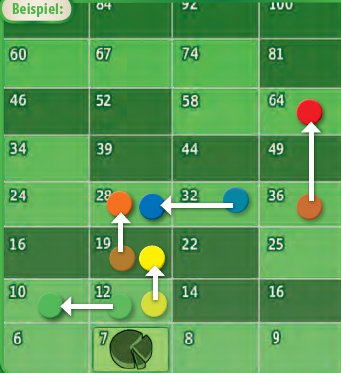 |
yellow 1 space upward (to 19),
blue 1 space to the left (to 28),
red 2 spaces upward (to 64),
green 1 space to the left (to 10),
and orange 1 space upward (to 28).
He places the single black briefcase
in the bag. |
|
When he draws two or more black briefcases from the bag
and subtracts the number drawn from each number of colored briefcases drawn, the result can be negative, resulting in reduced prices.
He increases the price of silver by the number of black briefcases he drew and then adds the black briefcases to the market.
When a stock marker is at the right edge of the table and the adjustment would move it to the right, the player moves it upward instead.
When a stock marker is at the left edge of the table and the adjustment would move it to the left, the player moves it downward instead.
Example 2
During the next price adjustment, the player draws the following briefcases:
 |
1 yellow, 1 blue, 3 green, and 2 black.
He subtracts 2 from the number of each colored briefcase drawn, resulting in:
yellow -1, blue -1, red -2, green 1, and orange -2. |
Thus, he moves the stock markers accordingly:
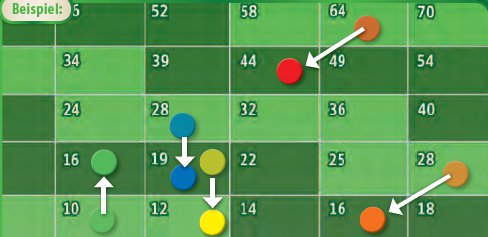
yellow 1 space downward (to 12),
blue 1 space downward (to 19),
red 1 space downward and 1 space to the left (to 44),
green 1 space upward (to 16),
and orange 1 space downward and 1 space to the left (to 16).
He adds the 2 black briefcases to the market. |
After all markers are adjusted, he places the drawn briefcases in the market.
The player places all colored briefcases from the table that initiated the price adjustment into the bag
and the black briefcases in their supply on the game board.
If a sales table initiated the adjustment, the players use the next sales table.
After the third sales table is cleared, the players load the second sales table.
When that is cleared, they load the third, and so on.
If, after a price adjustment, there is no briefcase of a color in the market, the player moves the stock marker for that color 1 space upward.
Now the silver price table is adjusted:
for each 3 silver bars (rounded down) that were bought since the last price adjustment,
the player moves the price marker on the silver price table up 1 space.
He moves the marker on the silver buys table to zero.
Now, he looks at the share price with the highest value:
if it is at a level that was not yet reached, this level becomes the new current level
and the player places the card that has that level number on the space on the game board reserved for that.
It is possible that a level is skipped.
A level change will change subsidy limits, purchase limits, and/or the number of briefcases that are drawn for the next price adjustment.
If no new level is reached, the current level card remains.
If the share prices drop to a lower level, the current level card also remains.
The game never goes back to a previous level.
Example 3
After selling a share, as there are only 5 colored briefcases on the current sales table, the player initiates a price adjustment.
As we are on level 6, the player draws 9 briefcases from the bag:
 |
1 blue, 2 red, 4 green, and 2 black. |
Accordingly, he adjusts the prices as follows:
 |
yellow to 28,
blue to 92,
red to 34,
green to 108,
orange to 34. |
Then, he adjusts the silver price table upward 5 spaces to 70,
since it moves up 1 space for each black briefcase drawn and each 3 bought silver bars (rounded down).
He places the drawn briefcases in the market.
He puts the colored briefcases from the table that initiated the adjustment in the bag
and the black briefcases from that table in their supply on the game board.
As we are already at level 6 and no stock marker rose higher than that, the level 6 card remains.
For each level achieved or skipped, the player puts a black briefcase in the bag from the black briefcase supply on the game board.
Now, the next player takes his turn. |
Game end
The game ends as soon as the silver marker in the silver price track reaches 100.
Any increase beyond 100 is ignored and the marker remains at 100.
Now each player sells all his shares, takes subsidies up to the subsidy limit and buys as many silver bars as he can (up to the limit).
The player who now has the most gold bars is the winner.
If players tie for most, the player among them with the most silver bars is the winner.
If there is still a tie, the player with the most cash wins.
Notes
Players can never pay back subsidies.
Also, at game end, players suffer no penalty for the subsidies they have.
The subsidies are offered by the state to assist the players in the distressed economy.
A player who chooses to take few or no subsidies saves the interest payments and gains the respect of the other players.
However, the game has no "moral winner".
In the end, the player with the most gold wins, regardless of the number of subsidies he has taken.
All briefcases that are on the sales or silver table offer a potential advantage for the owners of shares of those colors
as these may end up in the bag and could be drawn on a price adjustment.
Each briefcase that is drawn during a price adjustment can raise the price or,
at least, reduce the price reduction of that stock.
Interest must always be paid completely.
If a player cannot pay interest during a price adjustment,
he must take a subsidy card or sell shares during his next turn to pay the interest.
No share price can sink lower than 4.
If a share is at this value and would have to sink further, it stops at this value.
Special actions
Each player except the start player takes a special action card at the beginning of the game.
The player can use his special action card just once in the game.
 | PLAYER 2:
PASS: Additionally, on his turn, the player can move a briefcase
from the market to the silver purchase table.
He can do this at the very start of his turn or at any time during his turn. |
 | PLAYER 3:
SELL +1: when the player chooses the action "sell shares",
he may sell 1 more share than the stated limit on the level card.
It takes the current price for that extra share from the bank. |
 | PLAYER 4:
BUY SILVER +1: when the player chooses the action "buy silver",
he may buy 1 more silver bar than the stated limit on the level card.
He pays the stated amount for the extra silver bar. |
 | PLAYER 5:
BUY +1: when the player chooses the action "buy shares"
he may buy 1 more share than the stated limit on the level card.
He pays the stated amount for the extra share. |
If a player wants to add a briefcase to the silver purchase table, the only special action that will do that is "pass".
All other special actions influence only the quantity of the bought or sold units
and can only be used when the player chooses the appropriate action as the action for his turn.
Special rules for 2 players
At the beginning of the game, players place only 2 shares of each color in the market,
and then they draw 20 random briefcases to add to the market as normal.
Beginning with the start player, both players move one briefcase each from the market to the purchase table.
Each player takes two special action cards SELL +1 and BUY +1.
Player 2 also takes his normal special action card.
Special rules for 5 players
All spaces of the purchase tables are used.
A price adjustment is initiated, when exactly 6 spaces of a purchase table are filled,
or there are exactly 4 colored (not black) briefcases on the current sales table.